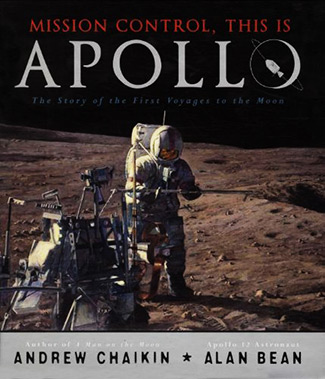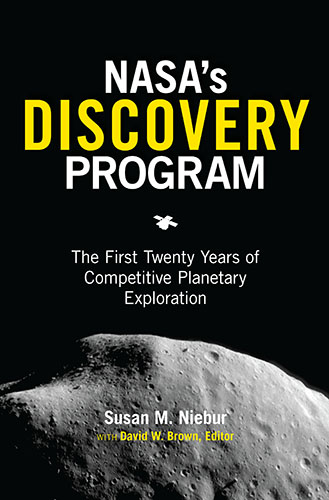Category: Children’s Book
Reviewed by: Marianne Dyson
Title: Mission Control, This Is Apollo: The Story of the First Voyages to the Moon
Author: Andrew Chaikin, with Victoria Kohl
Illustrator: Alan Bean
Ages: 9-12
NSS Amazon link for this book
Format: Hardcover
Pages: 128
Publisher: Viking
Date: May 2009
Retail Price: $23.99
ISBN: 0670011568
Andrew Chaikin and Alan Bean are a powerful team for introducing the Apollo program to a new generation. Few authors can compete with Andrew Chaikin when it comes to telling the stories of Apollo, and Apollo 12 astronaut Alan Bean is the only artist who can paint the Moon with the passion of personal experience. The combination of their talents has produced Mission Control, This is Apollo, a book that will appeal to a much wider audience than the targeted 9-12 age group.
The Bean artwork and captions are sufficient to promote this book to coffee-table status, and the expertly-crafted text is also consistent with a book that any adult could happily browse and digest while waiting for an appointment in a swanky office. The fortunate preteen readers who have copies given to them will likely linger, as I did, over the fascinating photos and paintings, and reread the stories until they can impress their friends and teachers by reciting the many historical details included in the book.
The book opens with a photo of the Moon showing the six landing sites and a one-page “cheat sheet” of terms such as “Command Module” and “undocking” that takes the place of a glossary. Next is a “Word from the Artist” outlining Bean’s transition from astronaut to artist, and including his comments on the cover and front matter paintings. Although choosing a favorite is close to impossible, the spread just before the introduction, “Scouting For the Right Spot,” of Bean and Conrad is most definitely near the top of my list.
Instead of chapters, the book is organized chronologically by missions. The first section is a several-page summary of the genesis and context of the space race between the United States and the former Soviet Union. Chaikin concisely explains the challenges the Apollo Project faced, and how the Gemini program was needed to build the capabilities necessary to attain the goal of a human round-trip to the Moon.
Chaikin makes liberal use of one-page sidebars to further explore topics such as the selection of the first astronauts, Mission Control operations, space sickness (including that the reason for weightlessness is falling!) and the excitement of the first live television broadcast from the Moon. Young readers (and curious adults) will learn, in exacting detail complete with photos, how Apollo astronauts went to the bathroom in space and then kneaded their feces with a germicide.
The descriptions of each Apollo mission, from Apollo 1 to 17, include all the must-know facts needed for student book reports and essays, and enough of the personal stories of the people involved to give the reader a solid understanding of the missions’ historical context and impact. The text is likely to prove challenging for juvenile readers because of long, complex sentences containing lots of multisyllabic and technical words which are not defined in the context or in a glossary. However, the high interest subject should motivate even reluctant readers to sound out “environmental” and look up “disinfectant” and “simulator.” For example, the story of Apollo 9, told from Dave Scott’s viewpoint while flying solo in the command module, was so compelling that I felt as if I were floating beside him, watching the lunar module, Spider, out the window.
The Bean paintings, melding the vivid colors of imagination with the smooth precision of reality, are simply a joy to behold. The captions offer fascinating tidbits and unique insights into the challenges and accomplishments of our first lunar explorers.
With Mission Control, This is Apollo, Chaikin and Bean have created something that is more like a cherished family album or an artist’s portfolio than a children’s book. Space enthusiasts of all ages would do well to add this one to their personal collections.
© 2009 Marianne Dyson
Please use the NSS Amazon Link for all your book and other purchases. It helps NSS and does not cost you a cent! Bookmark this link for ALL your Amazon shopping!



















